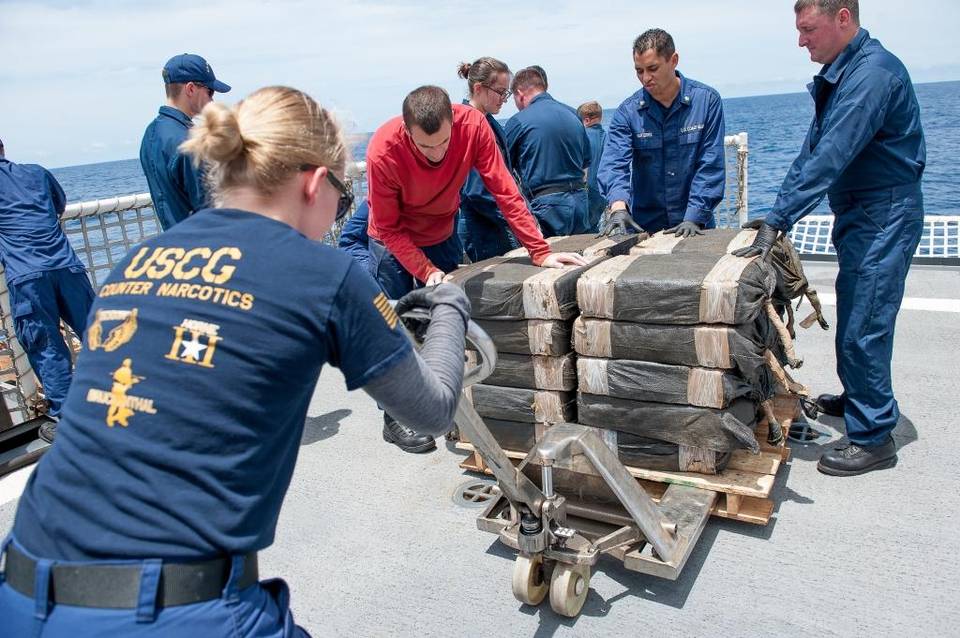USCG photo
By
Ricardo Swire
New drug trafficking patterns indicate the reintroduction of popular 1980s Caribbean routes. Drug shipment corridors between Peru, Colombia and the US are flexible, constantly evolving in response to law enforcement interdiction efforts or varying markets.
The area between Puerto Rico and South Florida is crisscrossed by clandestine routes, the most prominent Caribbean Basin Drug Trafficking Organizations operating from Mexico and Colombia.
In 2012 and 2013 the Dominican Republic was a major transshipment point for cocaine and other drugs originating in South and Central America. The drug trade in the Western Hemisphere has undergone significant developments. The US continues to be top destination for South American cocaine, Mexico the top transshipment route. However the path between Mexico and South America changed.
Due to law enforcement’s increased monitoring and interdiction of airborne and maritime routes, Mexican drug traffickers now depend more on land based smuggling paths. The Merida Initiative, a US anti-drug assistance program in Mexico, received US$300 million in one year towards interdiction efforts. The US additionally helped Central America with approximately US$100 million. Both were meaningful investments that posed substantial threats to regional trafficking operations.
2014 trends showed that Caribbean drug shipments tripled, cocaine consignments increasing from five percent to sixteen percent. According to the US Drug Enforcement Administration (DEA) transnational traffickers transported between ninety and one hundred tons of drugs through the Caribbean.
The 2015 National Drug Threat Assessment concluded that from eighty-seven percent of cocaine that arrived on the US mainland, thirteen percent journeyed via the Caribbean. Jamaica, originally a leading marijuana producer, diversified and increased cocaine trafficking on the island. Haiti’s popularity as a transit point grew, an increase that highlighted Hispaniola as a Caribbean drug trafficking colossus.
On May 11th 2016 national security intelligence shared by the Bahamas southern islands activated the archipelago’s Drug Enforcement Unit (DEU). A sixty foot freighter vessel, under maritime law enforcement surveillance, was intercepted in waters off the northern tip of Eleuthera, fifty miles east of Nassau. A search of the freighter revealed several hidden compartments that concealed packages of cocaine valued US$2 million. Six male Haitians found aboard were remanded.
Between September and October 2016 US Coast Guard/Customs & Border Protection (CBP) agents confiscated four hundred pounds of marijuana. The US$306,400 worth of drugs found in fifteen individual scenarios. Bails of cocaine floated on the ocean, while others washed ashore on Florida Keys beaches. Sunday night of October 23rd 2016 US CBP resources were again deployed, after receiving reports of a suspicious twenty-foot “Yola.”
The low profile wooden fishing boat sailed waters east of Aguadilla city in northwest PR. The Yola, powered by outboard engines, was stopped and searched and two hundred and eighty-three pounds of cocaine worth US$3.6 million were found. The two male Dominican crew were detained. Such scenarios reinforce concern that Caribbean decision makers urgently need a reality check.
Despite decades of US anti-drug efforts and partner governments, production and trafficking of cocaine, marijuana, opiates and methamphetamine generate a multi-billion dollar black market. Breaches of national security and safety will not wait for large scale reassignment of drug cartel operatives, or resources from crime riddled Mexico, Central and South America to arrive on individual Caribbean islands. The steadily increasing cocaine waystation accommodation will have a significant impact on internal security situations.



No Comments Yet!
You can be first to comment this post!